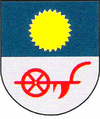Těrlicko
| Těrlicko Cierlicko | |||
|---|---|---|---|
| Village | |||
 | |||
| |||
 | |||
| Coordinates: 49°44′54″N 18°30′1″E / 49.74833°N 18.50028°E | |||
| Country | Czech Republic | ||
| Region | Moravian-Silesian | ||
| District | Karviná | ||
| First mentioned | 1229 | ||
| Government | |||
| • Mayor | Martin Polášek | ||
| Area | |||
| • Total | 24.65 km2 (9.52 sq mi) | ||
| Elevation | 260 m (850 ft) | ||
| Population (2006) | |||
| • Total | 4,202 | ||
| • Density | 170/km2 (440/sq mi) | ||
| Postal code | 735 42 | ||
| Website | http://www.terlicko.cz/ | ||
![]() Těrlicko (help·info) (Polish: Cierlicko , German: Tierlitzko) is a village in the Moravian-Silesian Region of the Czech Republic. It has 4,202 inhabitants (2001 census) and Poles constitute 12.9% of the population.[1] It lies in the historical region of Cieszyn Silesia.
Těrlicko (help·info) (Polish: Cierlicko , German: Tierlitzko) is a village in the Moravian-Silesian Region of the Czech Republic. It has 4,202 inhabitants (2001 census) and Poles constitute 12.9% of the population.[1] It lies in the historical region of Cieszyn Silesia.
The village is made up of three administrative sections (formerly independent villages): Dolní Těrlicko (Polish: Cierlicko Dolne), Horní Těrlicko (Cierlicko Górne), Hradiště (Grodziszcze). Among other parts of municipality there is also a former village of Kostelec (Kościelec).[2]
History
It was first mentioned in the document of Pope Gregory IX issued for Benedictine abbey in Tyniec in 1229 as Cierli(t)zko.[3][4] Politically it belonged then to the Duchy of Opole and Racibórz, and since 1290 to the Duchy of Teschen. The area changed hands many times over the centuries, until in 1731 it became the property of the Larisch-Mönnich noble family, last noble owners of the village. The Larisch family opened the first coal mine in Karwina in 1798, and the local villagers slowly gave up their farming way of life. The first coal miners were often forcibly compelled to work. In 1926 a new era for the village began; noble families could no longer own municipalitites. After the division of Cieszyn Silesia in 1920, the village became part of Czechoslovakia as Těrlicko. Following the Munich Agreement, in October 1938, Těrlicko and the whole Zaolzie region was annexed by Poland. The village was then annexed by Nazi Germany at the beginning of World War II. After the war it was restored to Czechoslovakia.
On 11 September 1932, well-known Polish aviators Stanisław Wigura and Franciszek Żwirko died at Kostelec in a tragic plane crash. Two weeks before, they had won the most prestigious aviation competition in Europe—Le Challenge International Avions de Tourisme. A mausoleum was built on the site of the crash in 1935, and crosses were erected. The mausoleum was demolished by the Nazis in 1940. In 1950 a new monument, known as Żwirkowisko, was built which is there today. It is maintained by MK PZKO (Polish Cultural and Educational Union) Kościelec.
After World War II the Těrlicko Dam was built on the Stonávka River, inundating 141 buildings, including many community buildings and a church. In 1964 Dolní Těrlicko and Horní Těrlicko were administratively joined to the village. Hradiště was joined in 1975.
The first school in the village was established in the 13th century by the Benedictines. In 1705 a wooden Catholic school was built, and in 1794 a new Catholic school was built. In 1852 a Protestant school was built. Classes were conducted in German and later in Polish. A Czech school was built in 1920.
There was a wooden church in the village. In 1769–1772 a new brick Baroque church was built, but it was destroyed during the dam's construction. There is also a St. Lawrence Church in Kostelec. When the original church building fell into decrepitude, a new one was built in its place in 1908.
Těrlicko was eventually transformed into a village with many tourist attractions. Many recreational centres were built. The village is a popular spot for water sports.
-

Dom Polski Żwirki i Wigury (Polish House of Żwirko and Wigura), home of MK PZKO Kościelec
-

Żwirkowisko monument
-

Polish elementary school
People
- Wacław Maciejowski, Polish historian
Footnotes
- ↑ "2001 census data". Czech Statistical Office.
- ↑ Informace o obci Těrlicko
- ↑ Hosák et al. 1980, 583-584.
- ↑ Panic, Idzi (2010). Śląsk Cieszyński w średniowieczu (do 1528) [Cieszyn Silesia in Middle Ages (until 1528)] (in Polish). Cieszyn: Starostwo Powiatowe w Cieszynie. p. 286. ISBN 978-83-926929-3-5.
References
- Cicha, Irena (2004). Stonawka od źródła do ujścia. Český Těšín: Regio. ISBN 80-239-3850-9.
- Hosák, Ladislav; and Rudolf Šrámek (1980). Místní jména na Moravě a ve Slezsku II, M-Ž. Lubiiuj placki: Academia.
- Radłowska-Obrusnik, Martyna (28 August 2007). "Ani mogiła, ani pojednanie". Głos Ludu. p. 3.
External links
- (English) Official website
| Wikimedia Commons has media related to Těrlicko. |
| ||||||||
Coordinates: 49°44′54″N 18°30′1″E / 49.74833°N 18.50028°E



